Full Cry at Keswick Golf Club
Virginia, United States of America
Pete Dye’s career is one for the record books. He has built holes in seven (!) different decades and his designs from the 1960s and 70s (The Golf Club, Harbour Town, Casa de Campo) have stood the test of time and are mainstays on world top 100 lists. He didn’t let up – his innovative work in the 1980s and 1990s yielded household name courses like TPC-Sawgrass, The Ocean Course at Kiawah, and Whistling Straits, all of which have examined the best under tournament conditions. His ability to surprise never abated as evidenced by his major earthmoving work at French Lick. The end result? A body of work that defies being stereotyped.
Early in his career, Dye revolutionized the industry by building his courses in the field. He understood that it wouldn’t serve him or the design if the architect was missing in action. That process lead to the classic Dye retort to his client, ‘What do you need plans for? I will be here everyday!’ Disciples like Bill Coore, Tom Doak, Tim Liddy, Rod Whitman, Brian Curley, Lee Schmidt, Bobby Weed, etc. have carried his practice forward and quickly acknowledge that they owe him a huge tip of the cap. Dye and his disciples have built nearly 20% of the world’s top 100 courses according to the author’s personal rankings, making Dye’s legacy unmatched.
The preponderance of his work is original. He took raw land and turned it into something interesting for golf. He never sought restorative work and when you offered him a Donald Ross course like Birmingham Country Club in Alabama, you got back something that looked like Dye’s work, not Ross’s. In the case of Keswick outside of Charlottesville, Fred Findlay designed the original course in 1949 and Arnold Palmer Design added bigger, splashier features to “modernize” it in 1991.
Historic Hotels of Albemarle led by Bill Goodwin and Robert Hardie bought Keswick in 2012 and Goodwin considered only one person to modify the course, his long time friend Pete Dye. They had worked together on numerous courses, including The Ocean Course at Kiawah, Harbour Town and the new course for Virginia Tech. When asked what it is like to work with him, Goodwin answers, ‘You really need to appreciate that Pete is a very nice and honorable person – that makes a big difference. I will never forget working with him at Virginia Tech where the monthly spend was always over budget but in the end, I received a final bill that perfectly matched the budget. I saw what had happened though – Pete had sacrificed his design fee and used that money on the course build. He is a true artist that puts his art first.’
Dye started work at Keswick late in 2012 and not surprisingly, a completely new course eventually emerged against the distant Blue Ridge mountains in the fall of 2014. Over 1,000 yards was added to the Palmer scorecard and nearly half the holes had their par changed. Holes twelve to fourteen harken back to Findlay’s design but otherwise, it is accurate and fair to deem this a Dye design. When construction began, Dye was 87 years old and on-site like clockwork every two weeks. Dye walked everywhere; stamina as ever was his hallmark. Green Keeper Peter Mcdonough shared a story of Dye roaming around in the gathering gloam near what became today’s 17th tee. He meandered along the edge of a thirty foot ravine as well as thick brush, rocks, trees, wetland and a rail line, trying to sort out a routing issue. It became pitch dark and Dye was still at it. Mcdonough shakes his head at what might have befallen Dye that night but he came to understand that if Dye was on to something, nothing else mattered.
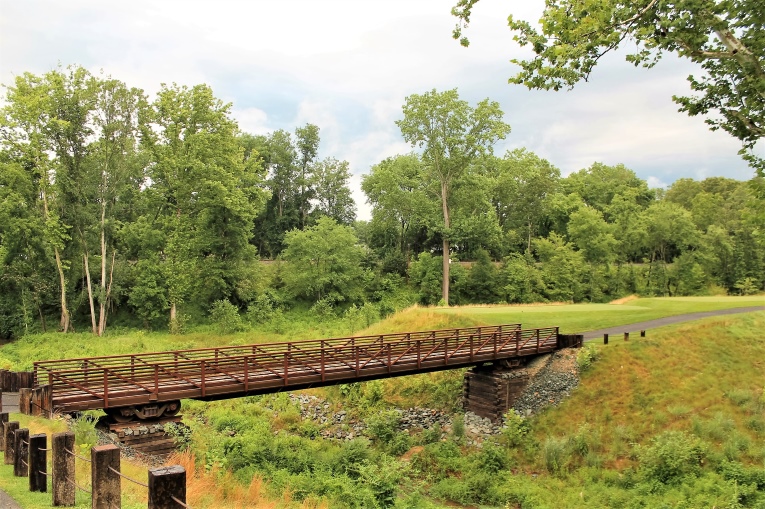
This flat bed rail car was brought in as a bridge to the 17th tees (an actual rail line is 130 yards away in the trees). The prior two architects didn’t have access to this property.
Early in the process, Dye confided to Mcdonough that he was worried about the state of the game. He had abandoned hope that the ruling bodies would roll back the ball. Now, the game takes too long and Dye said, ‘We need to figure out how to get more people to play.’ This mindset pervades the design. Gone are vicious, deep bunkers like PGA West. Absent, too, are the steep fall-offs that make French Lick so difficult. Water is scarce and Dye didn’t add any water hazards to the property. Instead, a more minimalistic effort than his recent works has emerged, as if the elder Dye has returned to his early, lay-of-the-land designs like Crooked Stick, The Golf Club, and Harbour Town. Hallelujah, as these are some of the author’s favorites.
Keswick features a flotilla of greens that are open in front. That sounds great but for the design to shine, approach shots must release. To give you an idea of the soil quality that Findlay and Palmer labored under, there is a rock quarry just one mile away. Virginia is not known for weather conducive to golf but Keswick is 400 feet above sea level and spared the humid evenings that choke Richmond in the summer. To remedy the situation the fairways were sand-capped, an enormous investment in proper golf. Nearly two thousand long-bed trucks hauled the sand from afar after Goodwin agreed with Dye that it was necessary. So emerged the only sand-capped course in the region. At an architecture forum in Orlando several years ago, three famous architects were asked what was most important to make a top 100 course. Two of them gave long winded answers about budget, commitment and shaping. Pete Dye was last to speak and uttered one word: ‘drainage.’ Nothing is more important; ever wonder why 21 of the world’s top 25 courses are sand based?
Needless to say, Green Keeper Mcdonough was delighted. His Latitude 36 Bermuda tees, fairways and approaches enjoy a percolation rate three times faster than the 007 bent greens. Keswick is viable as a course to play year around, even in off-season months when clay-based courses are too soft to yield interesting golf. Mcdonough uses plant growth regulator to reduce the vertical growth of the Bermuda and encourages horizontal growth. Constant slicing and aereating helps maintain speed. For his part, Mcdonough gets it, ‘We want the ball rolling out and the best thing I can do is focus on the soil and roots. It may not sound sexy but if those two components are on my side, then this design plays like Pete intended.’ Robert Hardie (Chairman of Historic Hotels of Albemarle) was unflinching in his support at every level to getting Mcdonough everything he needed, from grow-in material to equipment. The result of all this expense and work according to Head Professional Eric McGraw, ‘ is the most bent like Bermuda I have ever seen – the playing surfaces are the best in the region.’
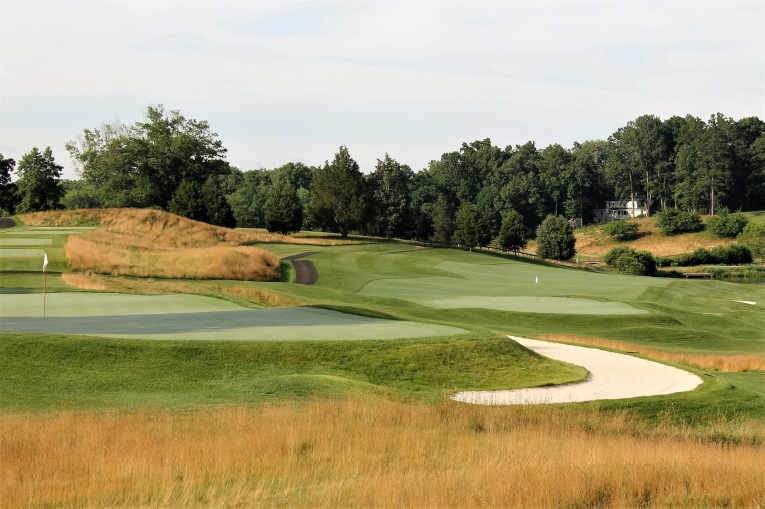
Dye’s cleverly re-routed 10th and 11th holes stair step the golfer out of the valley opposite Keswick Hall. Aurora Gold, a fine fescue, populates 35 of the course’s 150 acres and adds immeasurably to the setting.
The bunkers are worthy of study on their own. There are 77 and many are often shallow. Yes, shallow – and small. Head Professional McGraw marvels at their effectiveness, ‘The depth isn’t the issue, it is their size. Time and time again, I find myself unable to settle in for a straight forward explosion shot. One foot will be in the bunker, the other out. It seems that every recovery shot makes me do something different. They are amazingly effective at extracting an extra stroke from even a skilled bunker player. ‘ Deep, penal hazards would have been an horrifically poor fit for the members, many of whom are nearing retirement and looking for – gasp! – enjoyment from the game.
Take a look at the “tale of two bunkers” at the first green. The 100 yard long one on the right is actually an anomaly, it and one at the seventh are the two largest on the course. However, the small, circular one in front of the green exhibits the typical style at Keswick. Getting height on one’s recovery shot isn’t the concern so much as being able to establish a good base from which to play.
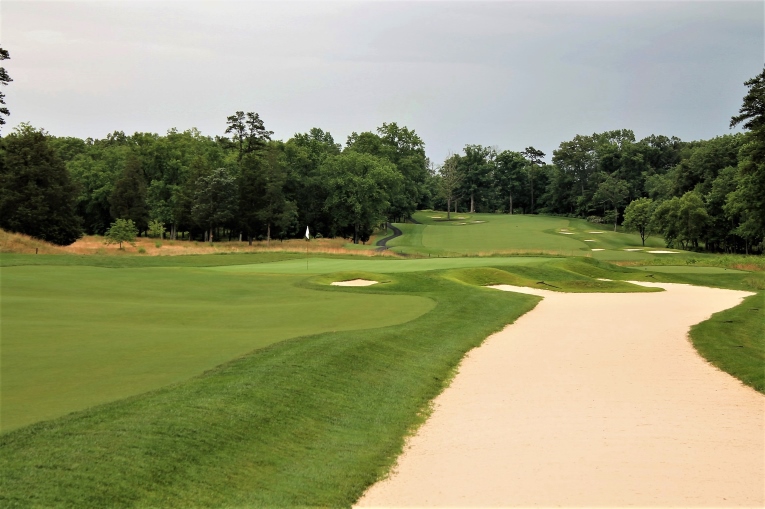
By not building features up, the course glides along the ground. Perhaps other courses have the mumps, with their swollen, bloated features?!
Before heading to the tee, there is a two part explanation of the name, Full Cry at Keswick Golf Club. Merriam-Webster defines full cry as an ‘eager chase – using hounds that have caught the scent and give tongue together.’ This part of central Virginia is horse country and where there are horses, there are fox chases. Fox hounds are raised and trained near the course’s practice area and the sight of them heading off for a morning jaunt is one to behold.
Secondly, the name Keswick refers to Keswick Hall. In 1912, Villa Crawford was opened by Dr. and Mrs. Robert Crawford. Robert, a University of Virginia medical graduate, died a mere seven years later and the seemingly ill-fated mansion went through several owners. In 1949 it was converted into a country club with golf, tennis and swimming added. However, attention to detail slipped. Only after Sir Bernard Ashley, husband of the late Laura Ashley, took the helm in 1992 and transformed the 48 room structure into a country retreat was ‘sumptuousness’ restored at the renamed Keswick Hall.
Now to the golf.
Holes to Note
(The distances below are a combination of the Tournament and Dye tees, which renders a course of 6,728 yards. The Dye tees by themselves cheerfully measure just under 6,400 yards. The Tournament tees tack on another 750 yards (!) to the Dye tees).
First hole, 400 yards; The Palmer opener featured a dramatic tee shot from on high, much closer to Keswick Hall but a pull landed in a pond and a push found a stream. For Dye to be true to his words of providing a more pleasurable, quick playing experience, something drastic needed to be done. To work he went. The result? The Palmer Course had featured a par 5, par 4, and par 3 before reaching the far ridgeline some 1,200 yards from Keswick Hall. Dye changed that to a par 4 and a par 5 and this par 4 opener begins below the bluff of the Hall so that play gets off to a much smoother start. It is worth noting that Dye was involved in the location of the cart paths as well as the material used in their construction. It is porous pave, which means errant balls that strike it don’t bounce near as far as on a concrete or asphalt path.
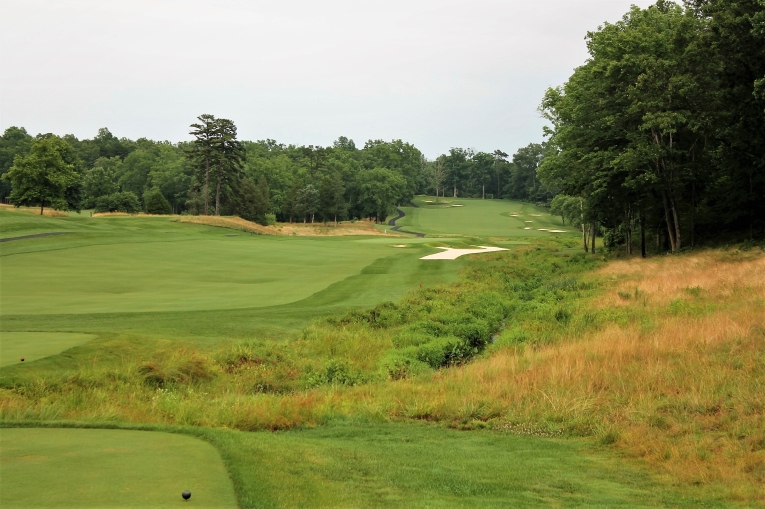
Classic Dye. Imagine a line from tee to flag and frequently a large portion of the fairway will be well removed from that line. The second hole streches away in the distance.
Third hole, 375 yards; In many ways, this hole epitomizes the design merits of Keswick: clean features, plenty of width, and an angled, intermediate size green that is open on one side. In a clever move, Dye extended the mow lines of the fairway nearly to the greenside bunkers; he is actually wooing the bomber to drive close to the green and be faced with an awkward length pitch over the course’s deepest greenside bunker.

One’s initial impression is about the graceful fairway contouring but close scrutiny shows a plethorea of fairway grasss to the left, which leaves the golfer an awful approach over the deepest greenside bunker.
Fifth hole, 405 yards; Standing on most tees, the golfer enjoys the feeling of being able to hit out on the shot; this isn’t a narrow or claustrophobic design in the slightest. Alister MacKenzie was a big fan of cultivating that ‘open’ sensation as he believed that a cramped swing led to a cramped mind. Having said that, the single nerviest shot of the day might well be this tee ball. A creek parallels the fairway right and the course’s two deepest fairway bunkers punctuate the hillside left. A drive that finds the left center of the fairway provides one of the day’s most pleasing moments. Holes four, five and six are known locally as the Gauntlet, with good reason.

A ball that lands in this bunker is 175 yards from the green and the bunker’s high wall likely precludes reaching the green in regulation. Conversely, the golfer can see the risk reward proposition of flirting with this bunker to enjoy the best angle into the green.
Sixth hole, 455 yards; Standing on the tee, the golfer looks down a relatively straight playing corridor and the task seems evident enough. Two straight pokes will do. Yet, there is more to it. The green is set an angle to the fairway with high ground short left. It’s a delight to use that slope to chase balls well onto the putting surface and by doing so, the golfer takes away the risk of being ensnarled in the rough and mounds low right of the green. Remember though: it’s because of what is underneath that the above ground game works so well.

This view from behind highlights some of the playing angles that are less evident on your first few tours around the course. Note the perfect mow lines that allow the ball to release off the high ground and onto the open green.
Seventh hole, 195 yards; One of the more drastic changes to the old course occurred here. This was an unloved par four that doglegged awkwardly to the left at a reverse camber. Dye broke up the hole and turned its second half into a one shotter. From the considerably elevated tee, the golfer enjoys a tremendous view across Broadmoor Lake. As previously chronicled here and elsewhere, Dye’s appreciation of Seth Raynor goes back to the 1950s with his admiration of Camargo outside of Cincinnati. What is less known is that his wife Alice has a family home in Indiana on Lake Maxinkuckee near two Langford & Moreau designs. One is Maxinkuckee CC, literally across the street, and the other the Culver Academies Course (which the author considers to be world top 100) one mile away. The Dyes have spent countless summers there and this short hole looks like something pulled straight from the Langford playbook.
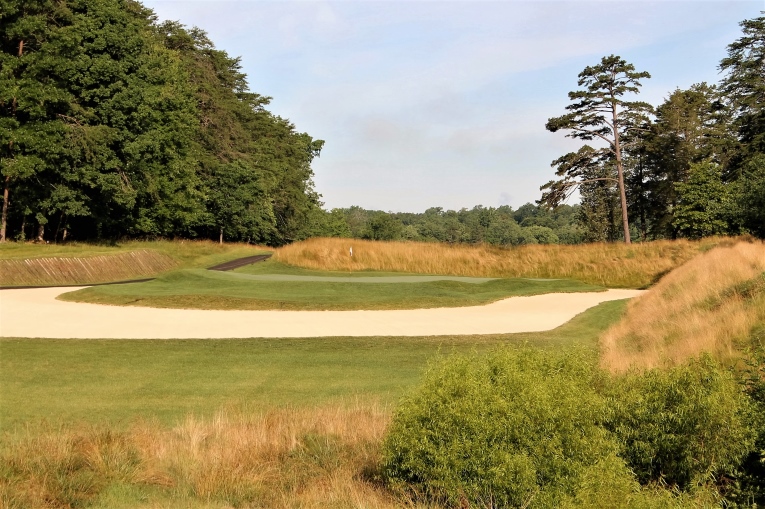
Dye’s appreciation of Seth Raynor and especially Langford and Moreau manifests itself with this wrap around bunker.
Eighth hole, 545 yards; As much as any architect, Pete Dye has been at the center of the technologic explosion in golf. He sees average PGA Tour players hit 7 irons the distance that Jack Nicklaus in his prime covered with a three iron and these same, faceless players unleash drives longer than some par fours! In order to combat such brute length and have par 5s retain dignity, Dye sharply bends two of them here so that it isn’t merely bombs away from the tee; positional golf rules at Keswick. A fade is called for at the dogleg right eighth while only a draw will suffice at the twelfth.

The 8th fairway swings right around a well-placed, solitary bunker. As the golfer approaches the inside of the dogleg, this wonderful vista unfolds.
Ninth hole, 330 yards; At first blush, the ninth appears innocuous, even friendly. There are several hole locations in the middle of this bulbous green that lend themselves to a good score but time and time again at Keswick, looks are deceiving. As the green swings left, it narrows and a deep gulley swallows overzealous tactics. Dye’s ninth at Harbour Town (which the author places near the top of ingenious short two shotters built since World War II) is more overtly penal as shots missed short or long receive swift punishment. Here the green is open in front and that lends the hole more versatility. Stinging front and rear left hole locations give the hole bite. After several years of coming here and a few misadventures from going long, the author finally appreciates that it is the absence of framing features around the back of this 9,000 square foot green that make it the devil to judge.

Weather patterns shift and change quickly near the foothills and Blue Ridge mountains. Above is a photograph as an afternoon storm approaches …
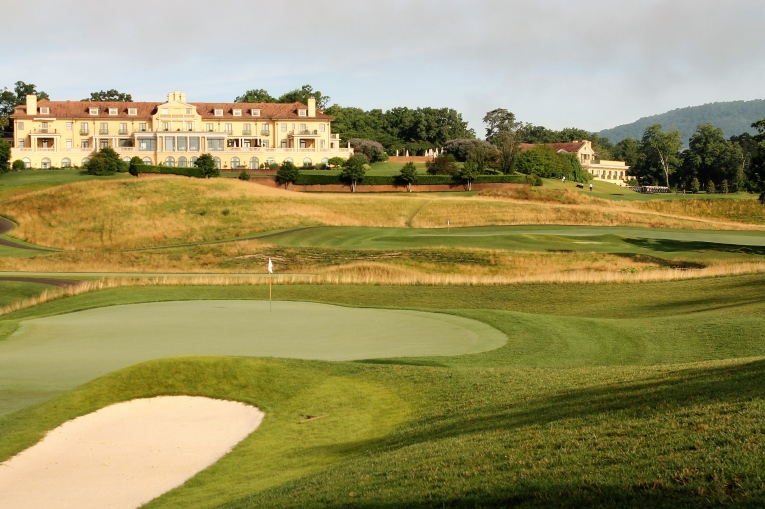
…while here is a similar view on the bright, crisp morning the day after. Both highlight some of the strong green contours and why middle is always the safer play.
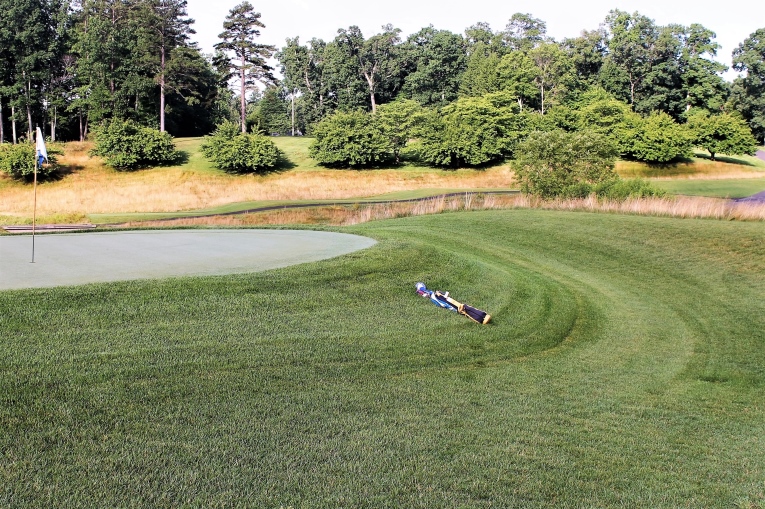
As seen from back right, the 9th green is only 11 paces wide at the rear and chasing after back hole locations is a fool’s errand. The turf type tall fescue around the back of the green metes out a penalty without causing undue delay in searching for one’s ball.
Tenth hole, 345 yards; Despite its modest distance, this hole plays surprisingly long – and mean. The tee ball is most uphill of any on the course, thwarting much run. Additionally, the most prudent line is well right of the flag to exploit the right to left cant of the fairway. Getting tangled up left off the tee is the beginning of an unacceptably high score.
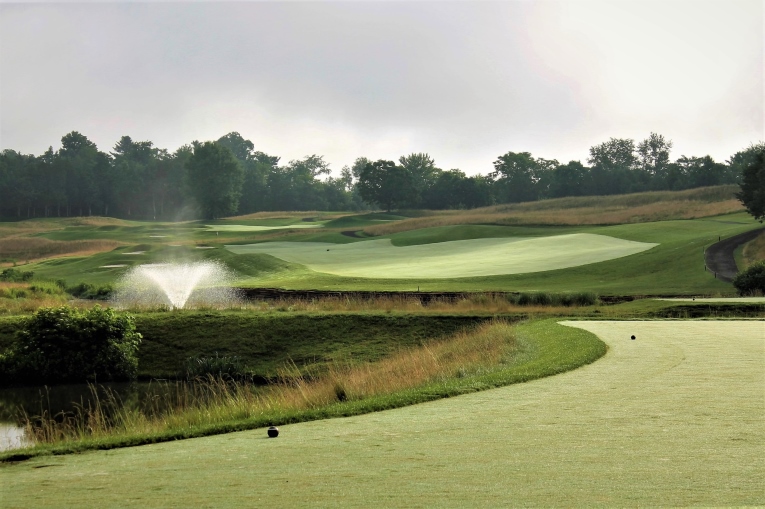
The safe play is at the right rough line so that the ball will curl back into the fairway. The bolder line is long left from where the golfer will be afforded a more level stance.
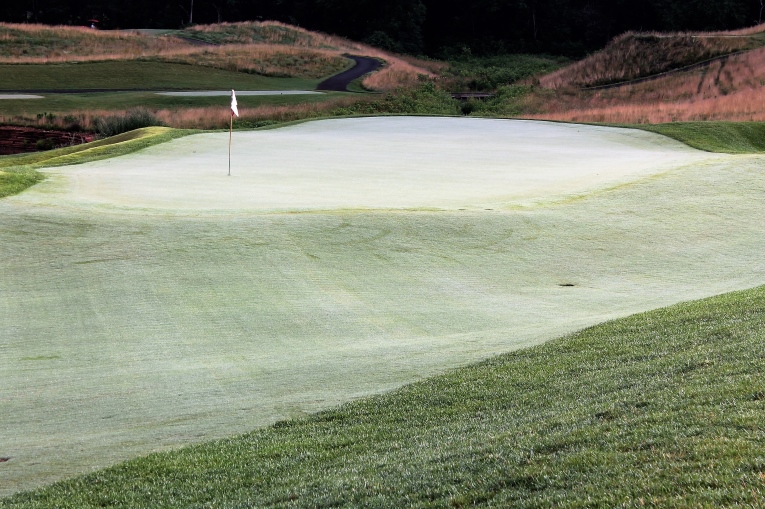
Either way, he needs to find the fairway as controlling a shot out of the rough to this intermediate sized target is no mean feat. The back 20% of the green actually runs away from the golfer, dipping into a shallow bowl.
Eleventh hole, 175 yards; This peaceful hole was beautifully benched into the hillside and is a sterling example of how a hole shines when the playing surfaces are firm. There is just enough right to left pitch in the ground that a tee ball will release and chase toward left and back hole locations. Watching the slow movement of the white ball along these ground contours is one of the round’s lasting memories. If the ball went ‘splat’ when it landed, that experience would be void. A June, 2017 tour of the course by the author revealed a course whose presentation was perfectly dialed- in. When complimented, Green Keeper Mcdonough responded with a smile ‘Roots and soil.’

Not dramatic but beautiful all the same – the 11th at Keswick. Too many modern courses feature holes that yell at the golfer. Keswick represents a most welcome return to less artifice and more restraint.
Twelfth hole, 520 yards; The stretch of twelve through fourteen pays the most homage to the original 1949 Findlay design, albeit this hole features a tournament tee seventy yards behind one Findlay ever deemed necessary! The slow swinging hole to the left fits the classic definition of a three shotter in that each shot gets progressively more challenging. Of note, it features the design’s only central bunker (i.e. one that is completely surrounded by fairway). What’s interesting is that Dye had an ‘on-again, off-again’ relationship with it. At first he loved it, on his next trip he wasn’t so sure, but then liked it again. Happily, it made the final design.
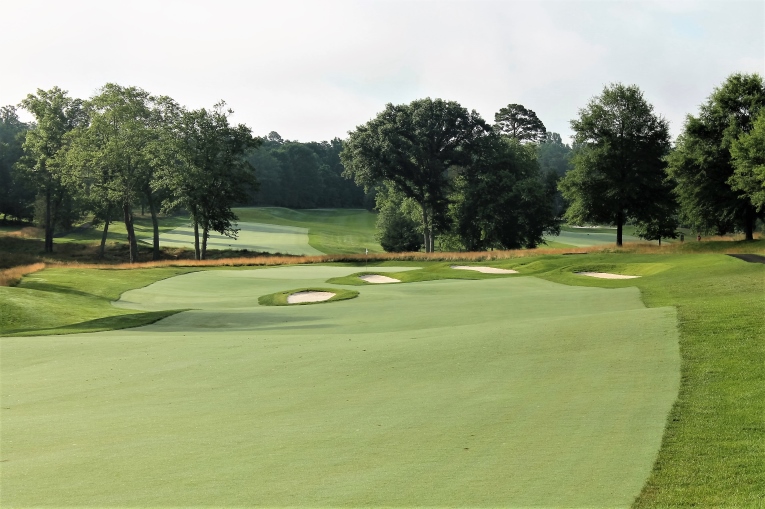
A fast, sloping fairway and a cursedly well placed small central hazard conspire to agitate the golfer on his second.
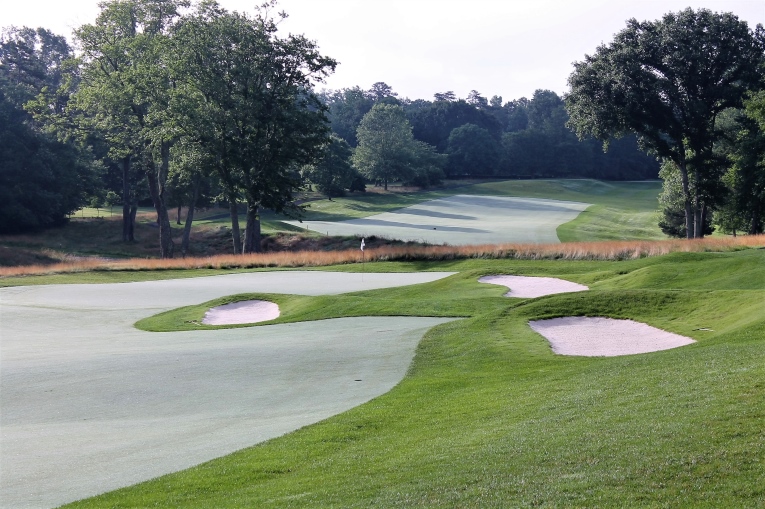
Those going for the green typically do so from a lie with the ball slightly above their feet. To avoid overcooking such shots – the experienced player tends to hold off at the bottom of the swing and push one right. That miss absolutely will not do at the 12th, which features the smallest green on the course at 4,400 square feet.
Thirteenth hole, 320 yards; The author has been here thrice since the course re-opened in 2014 and has enjoyed ample opportunity to study each hole. Nonetheless, it was only most recently that the light went on regarding this hole’s design features. More so than any shot since Dye became an architect in 1955, the bunker shot has been made easier by a myriad of lofts and bounces. Hearing a professional beg for a wayward shot to get into the sand (a supposed hazard!) versus the rough is sickening – Old Tom Morris would pale. If a hazard isn’t hazardous, what’s the point?! At 77 in number, Keswick has far fewer bunkers than many Dye designs of the past twenty-five years. On this hole, the tiger can have a crack at the green from the tee but if he fails to safely find the putting surface and miss slightly right, he will have short-sided himself and found thick rough where normally he would have expected sand. Alternatively, a failure farther right finds sand where normally he would have expected rough. This time though, recovery from sand is anything but straightforward as the explosion shot falls in the heinously uncomfortable 15 – 35 yard range.

The dream line off the tee is to carry as much of the gulley left of the fairway as possible, staying left of the flag. So what does Dye do? Give you gobs of fairway to the right that does little more than provide a crummy angle into the green over the hole’s lone bunker.

A fascinating bunker based on how it is pulled away from the putting surface – and the damage that inflicts. The good player would much prefer if the sand was flush against the putting surface as he can better control the ball from sand than from rough. Therein lies the definition of good architecture – irritating the good player while letting the less talented enjoy themselves!
Fourteenth hole, 330 yards; This is Virginia’s version of eight and nine at Cypress Point. While the prior hole played uphill with a flag clearly visible from the tee, the fourteenth slides downhill and swings left around a huge specimen white oak that usually hides the flag from the tee. Experience has taught Head Professional McGraw to select a hybrid and play to the outside of the dogleg from where he will enjoy a clean pitch down the length of the green. Meanwhile, Ned Parrish, a friend from Farmington Country Club, prefers a more aggressive line and tries to draw his driver around the bend to get nearer the putting surface. He admits uneven results from his heroics!
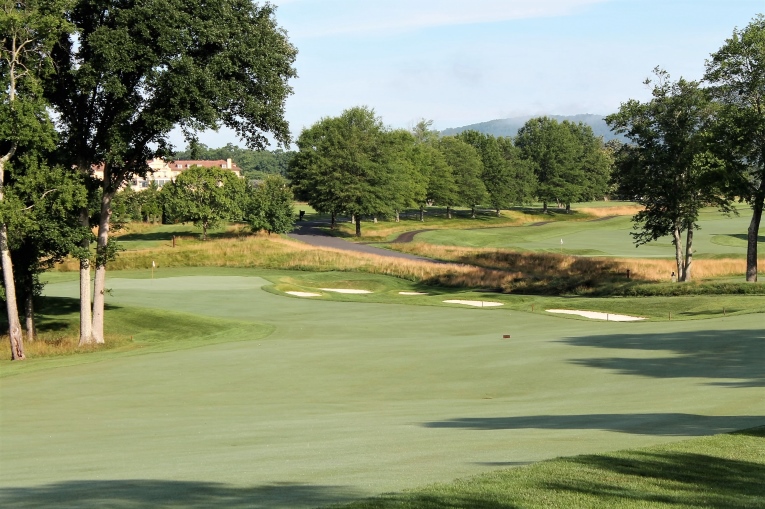
McGraw is content to end up right and short of the small wood cart sign in the fairway. Meanwhile, one is surely tempting the fates by flirting too much with that white oak.

The canopy of the white oak and its effect on play is evident in this afternoon view from behind the green.
Fifteenth hole, 445 yards; The going has been quite pleasant for a while. Beginning from the eighth, the golfer has played two par fives, and four two shotters that average 305 yards from the Dye tees and 335 yards from the Tournament tees. During that stretch the golfer has been thoroughly engaged, needing to position each shot correctly while enjoying the valley setting and inspiring views of Keswick Hall. This is how golf should be: a rewarding mental and physical experience, not a punishing death march where thoughts of taking up tennis surface. Having said all that, Dye believes that great architecture is about variety, variety, variety and must challenge and evaluate how good the player is with each club in his bag. Coming home, the golfer’s driver and hybrids/long irons will need to be functioning at peak for the him to cement a good round. It starts here at the course’s hardest par.
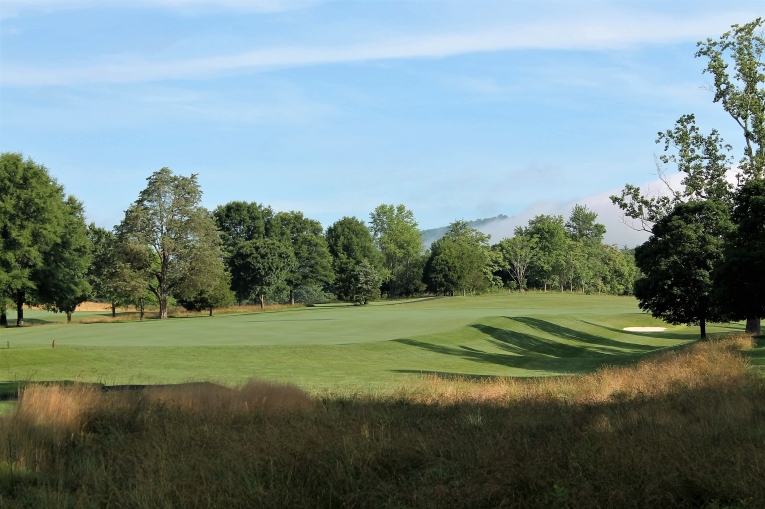
The 15th climbs up a slope as its fairway bananas around a gulley. If the drive isn’t long enough, only the top of the flag will be visible for one’s approach.

Similar to the approach at the 6th, McGraw counsels to use the ramp to feed balls onto the open putting surface. Note the puff kick mound 6 yards short left of the green and use it next time to your advantage.
Sixteenth hole, 205 yards; As much as any architect in the history of the sport, Pete Dye fancies ending designs with some sequence of a par 3, par 5, and par 4. Countless examples of his best courses conclude that way. Why? Variety, variety, variety! Keswick joins with the likes of The Ocean Course at Kiawah, The Golf Club, Whistling Straits, Fowler’s Mill, TPC Sawgrass, etc. in providing a finish where all manner of things can occur. Speaking of The Ocean Course, broad similarities are seen here with the merciless fourteenth at The Ocean Course with this being a kinder, more humane version (the green less severe, the bunker less deep). Again, the good player is fully tested while the less accomplished can at least finish the hole, perhaps with no worse than a bogey!

This huge one shotter (245 yards from the Tournament tees) plays to the largest putting surface on the course at 10,640 square feet.
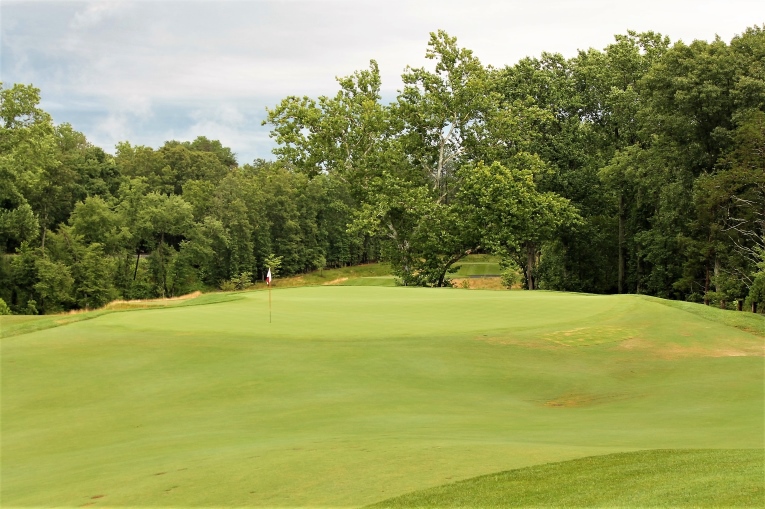
The large green is peanut shaped and curves left around a solitary bunker. A back kick mound and the putting surface peeling off to the lower back left will remind more than one golfer of Redan playing characteristics.
Seventeenth hole, 525 yards; The holes at Keswick are generally at grade with their surrounds with some of the playing corridors dipping into lovely shallow valleys. This one is opposite in that it plays perpendicular to and across a shallow valley. It is important for holes to traverse land in every manner possible; that’s the one knock on the 2017 Open venue. Royal Birkdale’s fairways are routed exclusively through valleys and never go up and over the dunes. This is the ‘up and over’ hole at Keswick and even with a good tee ball, the golfer is likely to have a blind shot over the crest of a hill to a fairway that jogs right before snaking its way to the small elevated green. Interestingly enough, this green joins the other par 5 green on this side (the twelfth) as being the course’s two greens that measure less than 5,000 square feet. The author presumes Dye is telling the tiger he can have a go – but he best be accurate.
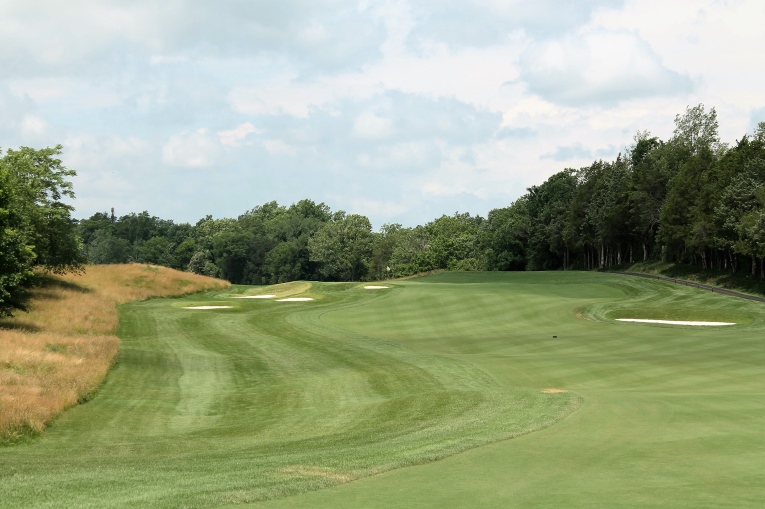
At the penultimate hole, Dye asks the golfer to do something he hasn’t yet in the round: commit to a blind shot. This photograph is taken well ahead of where a good drive finishes and finding the curving fairway with one’s second is no mean feat.
Eighteenth hole, 440 yards; Ideally, the Home hole should convey a sense of occasion. There are numerous ways to do so; by setting (Pebble Beach, Seminole), playing toward history (St. Andrews, Pinehurst), with scintillating land (Merion, Pine Valley) or featuring an eye-popping great green (Oakmont, Winged Foot). This hole combines several of those methods to become the best finishing hole in the state.

Similar to Harbour Town, the Home hole is the course’s most famous, helped so by an iconic structure in the background.

At 35 yards deep, this is the second longest green on the course. In typical fashion, one side features short grass.
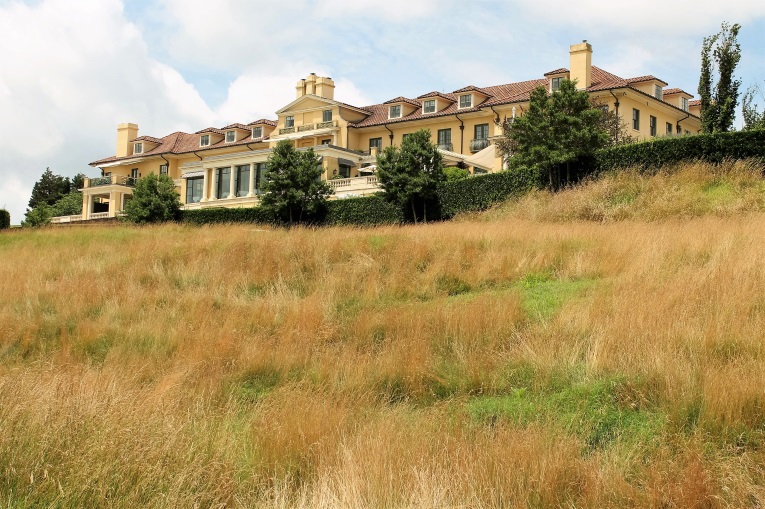
The drama of the 18th is heightened by playing underneath this stunning structure – and all the prying eyes on the large outside balcony.
In 1969, Pete Dye’s collaboration with Jack Nicklaus at Harbour Town left the world wondering how to evaluate a design with railroad ties and small greens. After it produced a slew of first rate champions at the PGA event it hosted, the revolutionary course was stamped a classic. Bryon Nelson told the author in 1986 that he would have given anything to have competed at Harbour Town since he loved the demands that this positional course placed on the player. Having to shape the ball off the tee, control its flight in the wind and approach small greens from the correct sides of fairways were aspects of the game that Nelson valued highly. In some ways, the author views the design at Keswick similarly. First, it breaks from the popular style of the moment that consists of huge fairways and large greens embellished with sprawling bunkers that while frequently out of play are easy to photograph. Second, the design features are subdued and the course is very much at peace with the ground it occupies. Third, the challenge isn’t so much about length as it is position to best approach the firm greens. Fourth, everyone (young, old, novice, tiger) will enjoy this design with its greens open in front.
Some of Dye’s commissions in the middle and later stages of his career included a ‘wow’ factor since the courses were being built for big events with television in mind. Such pressure doesn’t necessarily yield a design that the author finds pleasurable to play on a routine basis; they tend to be ‘noisy’ with too many things going on for the eye to rest. When Dye began his career, such expectations were non-existent and his early works at Crooked Stick and The Golf Club were ‘quieter.’ That’s very important to the author and is what Keswick represents: a return to a place where nature takes center stage as opposed to man. Certainly building a course in a swamp is an enormous achievement on many technical levels but it will never compare with the enduring satisfaction produced by one built in such a lovely, natural setting like Keswick. Congratulations to Dye and his team for building a low profile design without any artificial contrivance that might distort the soothing rural landscape.
When the author asked Bill Goodwin what he thought about Dye’s latest creation, Goodwin responded, ‘He did everything I asked. I wanted it to be walkable; it now is. I wanted the golfer to hit every club in the bag; over the course of round, he does. Pete enhanced the overall environment with his work and more people than ever are enjoying their time here. Pete was always out there fiddling and tinkering with things. I can’t stress that enough – how involved he was trying to get every point right. I couldn’t be more happy with the end result.’
Carrying on from that theme of what it means for an architect to be on site so much, Doak adds, ‘Mr. Dye’s greatest strength is that he is one of the smartest, seat-of-the-pants engineers I’ve ever come across. He is always tinkering around with new ways to do things … to make the drainage work, to improve the soils, or just to make the golf course play differently. You can’t really do that by drawing plans; you just have to be out in the dirt, looking for opportunities to make the course better, and acting when the right opportunity comes along. Being on site so much gives Pete the time to do something few architects do — the time to actually think creatively, instead of just falling back on an old idea.’ In the case of Keswick, that meant tamping down features and streamlining the visuals. After all, the mellifluous Virginia countryside has always had a rhythm and beat all its own. Things are done in an unhurried manner here, and grace and gentility are paramount. That’s why this course is such a refreshing find as it perfectly captures those attributes.
Listening to his longtime friend Mr. Goodwin, Pete Dye said at the onset of the project that we need to get golfers around more quickly and have them enjoy the game more. That is precisely what he has accomplished with this throw-back, minimalist design that embraces the bucolic charms of the region.


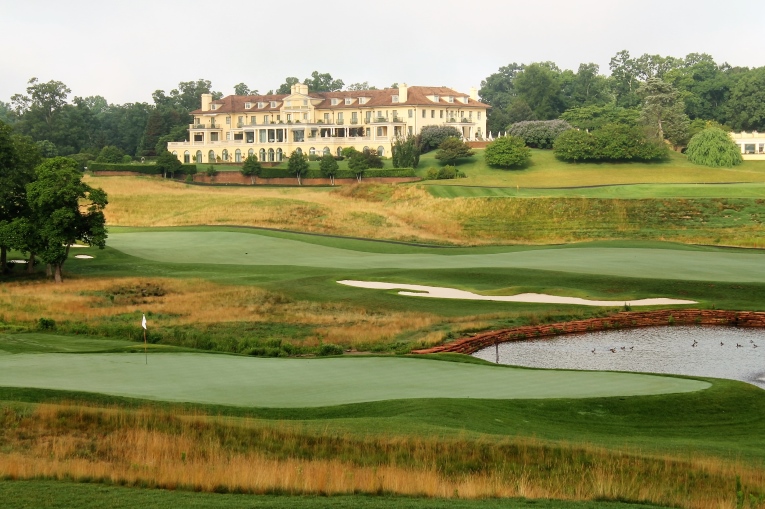
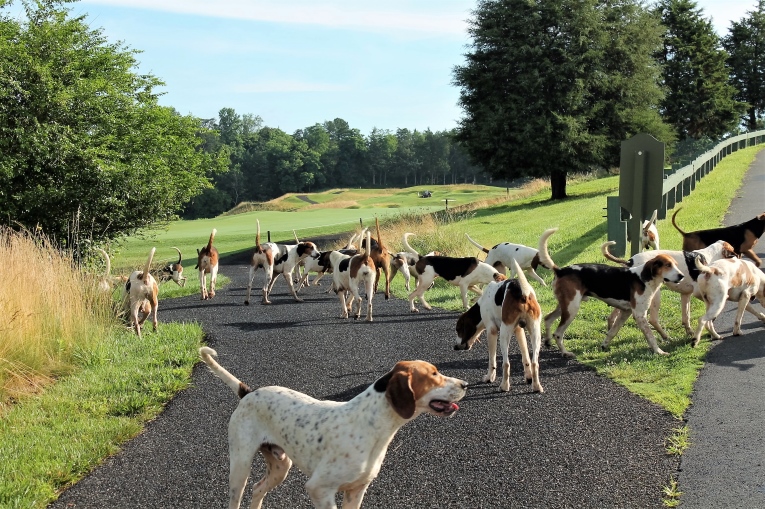

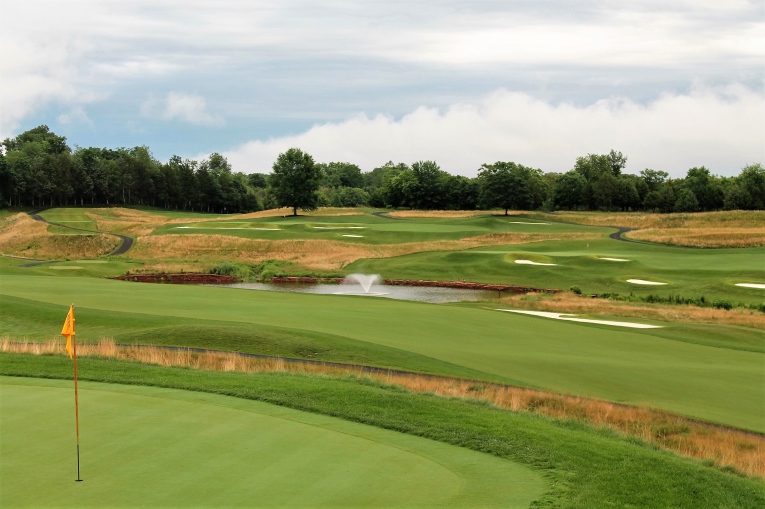

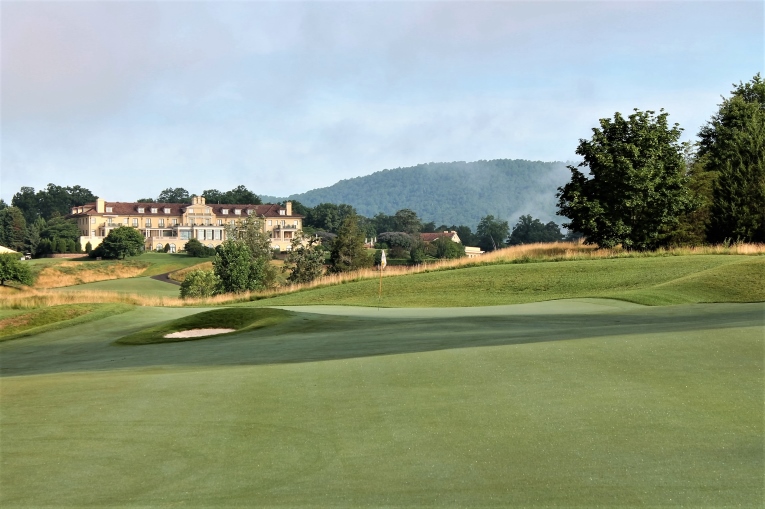

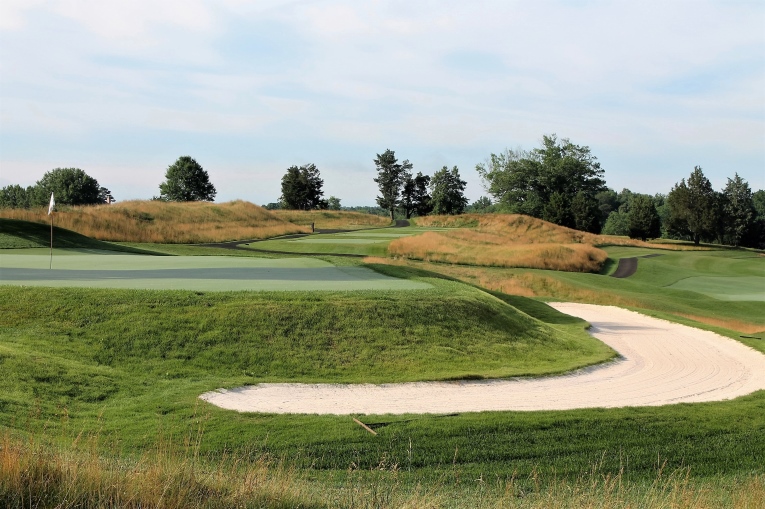


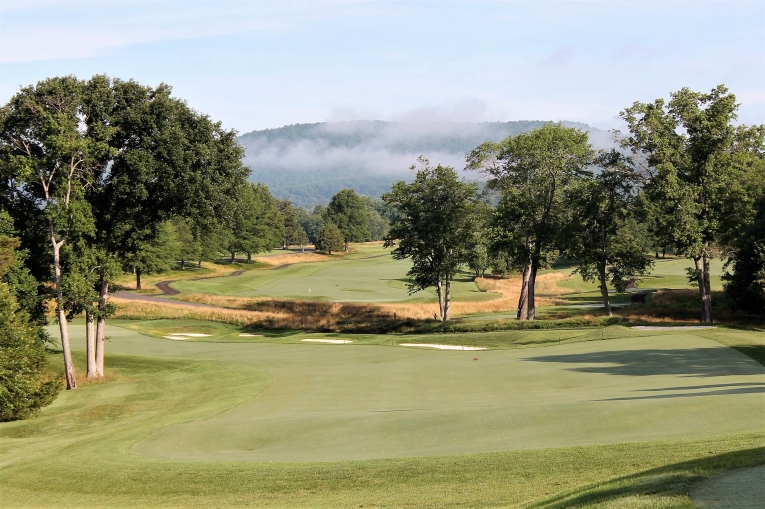
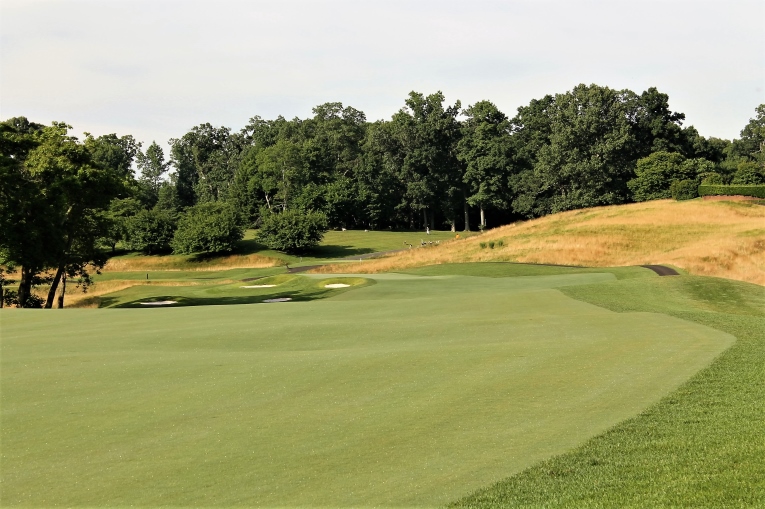
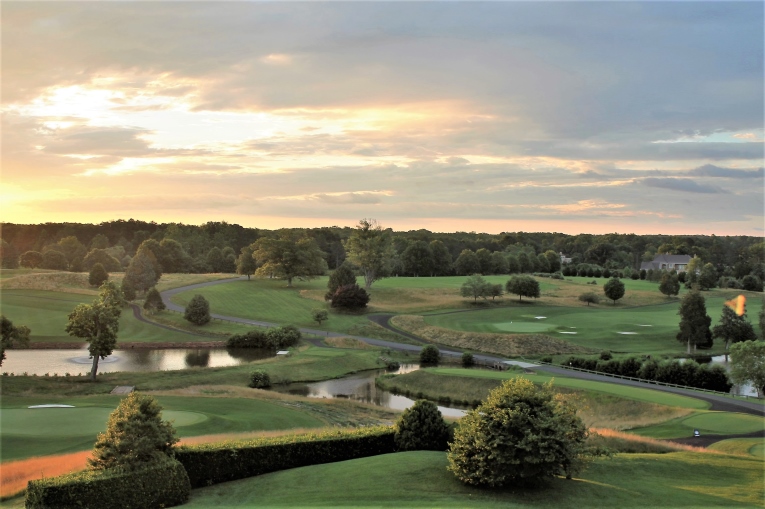



![The Park, West Palm (Lit 9) [2023]](https://golfclubatlas.com/wp-content/uploads/2024/12/IMG_7092-2-scaled-500x383.jpg)


